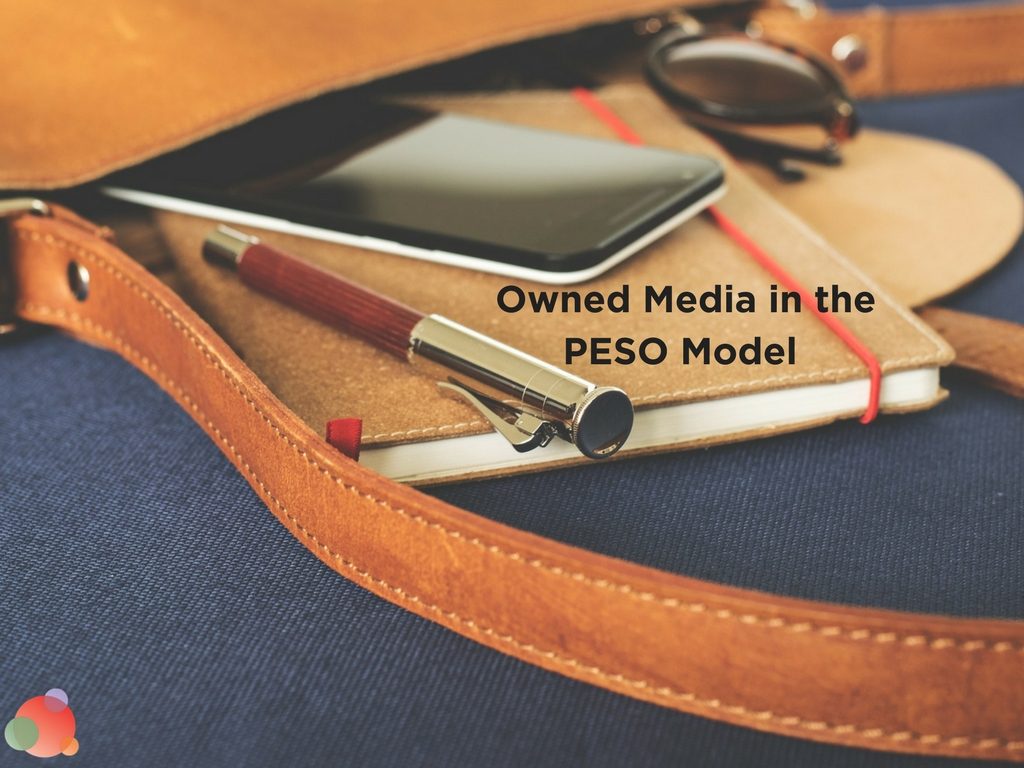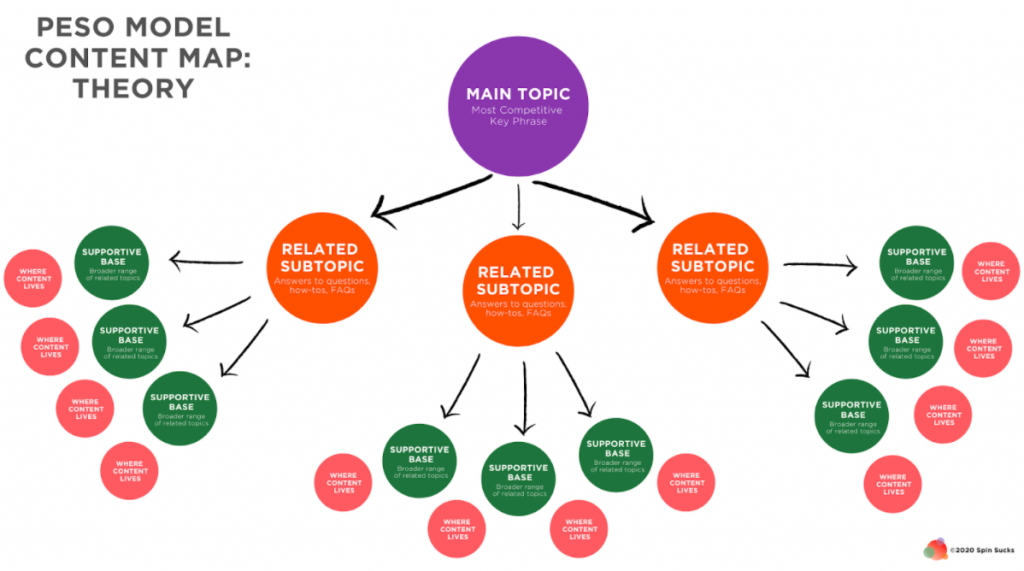 A few months ago, I had a fun debate with a college student about the PESO model. He wanted to know why it starts with paid when it’s pretty obvious a communications plan should start with earned or owned.
A few months ago, I had a fun debate with a college student about the PESO model. He wanted to know why it starts with paid when it’s pretty obvious a communications plan should start with earned or owned.
I agree!
If I were to use an acronym that placed the media types in order of importance—from a communications perspective—it would be OESP. But, as it turns out, that isn’t so easy to remember. And, in branding, using something that is easy to remember is the number one rule.
Hence, PESO.
Which leads me to the second piece in our PESO model series: owned media.
(If you missed the first piece, you can find it HERE.)
For communications, I place owned media first because, without content, you don’t have anything to share on social media.
Without content, journalists no longer believe you’re up-to-snuff (particularly if your competitors have content).
Without content, no one knows how you think–or what value you provide.
Your website stinks without content. You don’t have the search rankings you want/need without content.
It all comes down to content. And I’m not talking about the content that everyone produces. It has to have your thinking, your secret sauce, and your flair to it.
Owned Media Can’t Be Dry or Boring
A long, long, long, long time ago, I wrote a blog post about why I don’t think highly-paid speakers should wear jeans on stage.
To say it touched a nerve is putting it mildly. It also put Spin Sucks on the map.
I’ve since softened my view—and I certainly think there is a gigantic difference between looking like you rolled out of bed and wearing jeans that are neat and fit you well. But the fact that I put it out there, and it was so controversial, is what began to gain us some awareness.
And the best part? People disagreed with me, but were respectful about it.
Of course, I use that just as an example. Today, it wouldn’t drive business for us, nor would it convert leads (which seem to be the sum game of owned media today).
But it did gain us tons of new subscribers and the attention of some of the industry’s major influencers. To this day, people still give me a hard time about it. To which I almost always respond, “It was TEN YEARS AGO, people!”
The point is your owned media can’t be dry and boring. It can’t be full of jargon and corporate BINGO.
The reason content shock is a thing is because everyone tries to produce the same content.
And it doesn’t work.
Best Practices Are for the Birds
We know we should start with owned media.
We know journalists value being able to see the way we or our executives think before they use them as a source.
And we know the content has to be interesting and valuable and educational and informational and not sales-y.
But how?
First, ignore the best practices. There aren’t best practices for owned media. Best practices are the reason your content sucks.
As Jay Acunzo says:
Exceptional work happens when you find and follow what makes you an exception.
So ignore the best practices and let’s work on what makes you an exception.
What Is a Content Map?
A few years ago, Andy Crestodina wrote a fantastic article about content hubs. In it, he describes how to compete with the big boys—David versus Goliath, if you will.
The big key? Create content that makes sense for both humans and search engine spiders by focusing on your priority keywords.
To do that, you have to create a content plan that is focused on the main topic. That main topic has to be related to a priority keyword.
But here’s the rub: your keyword may not be what has high search volume or high competition. That’s OK! If you’re in a B2B organization, that’s actually better.
If you compete for something such as “copiers,” now is the time to get creative. You get to marry art (creativity) and science (keyword research) here so don’t get stuck on, “Wait. I can’t compete for ‘copiers’ and anything else has only 20 searches per month.”
The first thing you can do is ask internally if there is a list of priority keywords. Most often, someone in marketing or IT (don’t ask me why IT…computers, I guess?) owns it. Find it and review it.
Does it fit with your content goals…or do you need to tweak it?
For instance, if “copiers” is in the number one spot for the organization’s priority keywords, you can probably spend a bunch of money to compete for it, and that falls under paid media.
For owned media, you want to dig deep—not to mention, do you really want to create content for “copiers”? I didn’t think so.
You could possibly use:
- Multifunction copiers
- Office copiers
- All-in-one desktop copiers
- Mini copiers
- Digital copiers
- Best copiers
The opportunities are now endless—and you have a lot more fodder for interesting content.
(I got that list above by going to the Moz explorer, typing in “copiers” and then clicking on “SERP analysis” in the bottom right-hand corner to see what else was a possibility.)
Create Your Content Map
The following image shows you how to build your owned media program to fit your organization’s goals—and be creative so you’re not like everyone else.

The main topic is the priority keyword you’ve chosen—let’s say it’s “best copiers.” But your job isn’t finished yet. Now you have to write a headline that will go in the big purple bubble. Let’s make it, “The Best Copiers for Communicators to Use.”
Now you can dig down into the orange bubbles—which are related subtopics, answers to questions, how-tos, or tips. In this case, while we still use “best copiers” as our keyword, one related subtopic could be, “How to Find the Best Copiers for Media Kit Printing.”
(Clearly I am reaching here, but it’s a great example of how you can be creative while using the keyword and target your audience.)
Finish filling in your orange bubbles and then move to the green bubbles. Those are your supporting base topics—and still focus on “best copiers” as the keyword.
Here you could have a checklist called, “A Review of the Best Copiers.” This could be a one-pager that compares your copier to those of your competitors. While that may seem a little scary, think about the kind of trust you can build with new visitors because you’re transparent to show your warts as they compare to your competition. It works incredibly well.
If you were to take my “don’t wear jeans on stage” example, you can have a little fun with this. Perhaps your review of the best copiers runs during March Madness and you do a fake bracket with copiers that move out ahead each week.
It provides you an opportunity to really stand out, while keeping with the theme of the what’s happening in the world.
Owned Media In the PESO Model
You’ll notice there are orangish bubbles at the bottom of the map. Don’t worry about those yet. What you’ll do with them comes next week, when we talk about earned media—and how to begin to integrate the four media types.
For now, let me know what questions—in the comments below or in the amazing Spin Sucks Community—you have about owned media in the PESO model and building your content map.
This is the second in a series of blog posts about the PESO model, how to plan for it, how to implement it, and what to measure.
We recommend you review in order, but you can also jump to the one that best meets your needs. By the end of the series, you’ll have learned:
- Why communicators should embrace the PESO model
- How to use paid media in your communications programs and what to measure
- How to integrate earned media so it’s measurable and leads to organizational goals
- What to include in shared media and what to measure
- How owned media builds authority and thought leadership—and what to measure
- Metrics, a dashboard, and providing results to the executive team
PESO Model Series:
- PESO Model: A Week-by-Week Breakdown
- Where and How Earned Media Fits In
- Bringing Shared Media into The Mix
- Why Paid Media Belongs With Communicators
- Bringing it All Together with Thought Leadership
PESO Model Certification
Are you ready to take your career and results to the next level?
Do you want to learn how to build and scale an integrated communications program? One which drives real business results and shows the PR value clients care about?
Do you want to be able to measure your efforts so you can show the CEO your work directly drives sales?
Learn how you can become PESO Model Certified today.